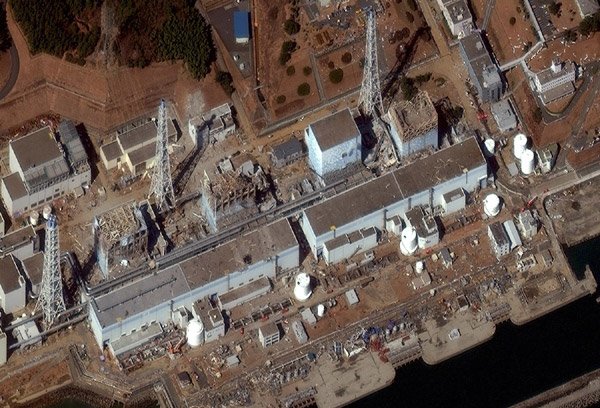Asia
Japan sees some stabilization in nuke crisis
Updated: 2011-03-19 19:50
(Agencies)
|
 (From R to L) Reactors No. 1 to 4 are seen at the Fukushima Daiichi Power Plant in Fukushima in this satellite image, taken and released by DigitalGlobe March 18, 2011. [Photo/Agencies] |
One of six tsunami-crippled nuclear reactors appeared to stabilize on Saturday as Japan raced to restore power to the stricken power plant to cool it and prevent a greater catastrophe.
Engineers reported some rare success after fire trucks sprayed water for about three hours on reactor No.3, widely considered the most dangerous at the ravaged Fukushima Daiichi nuclear complex because of its use of highly toxic plutonium.
"The situation there is stabilizing somewhat," Chief Cabinet Secretary Yukio Edano told a news conference.
Engineers earlier attached a power cable to the outside of the mangled plant in a desperate attempt to get water pumps going that would cool overheating fuel rods and prevent a deadly radiation leak.
They hope electricity will flow by Sunday to four reactors in the complex about 240 km (150 miles) north of Tokyo.
Edano said radiation levels in milk from a Fukushima farm about 30 km (18 miles) from the plant, and spinach grown in Ibaraki, a neighboring prefecture, exceeded limits set by the government, the first known case of contamination since the March 11 earthquake and tsunami that touched off the crisis. Click for details
But he said these higher radiation levels still posed no risk to human health.
Prime Minister Naoto Kan, facing Japan's biggest disaster since World War Two, sounded out the opposition about forming a government of national unity to deal with a crisis that has left nearly 7,000 people confirmed killed and turned whole towns into waterlogged, debris-strewn wastelands.
Another 10,700 people are missing, many feared dead in the disaster, which has sent a shock through global financial markets, with major economies joining forces to calm the Japanese yen.
Officials connected a power cable to the No. 2 reactor and planned to test power in reactors No. 1, 2, 3 and 4 on Sunday.
Working inside a 20-km (12-mile) evacuation zone at Fukushima, nearly 300 engineers got a second diesel generator attached to reactor No. 6 working, the nuclear safety agency said. They used the power to restart cooling pumps on No. 5.
"TEPCO has connected the external transmission line with the receiving point of the plant and confirmed that electricity can be supplied," the plant's operator, Tokyo Electric Power Co, said in a statement.
Nearly 1.5 km (a mile) of cable is being laid before engineers try to crank up the coolers at reactor No.2, followed by numbers 1, 3 and 4 this weekend, company officials said.
"If they are successful in getting the cooling infrastructure up and running, that will be a significant step forward in establishing stability," said Eric Moore, a nuclear power expert at US-based FocalPoint Consulting Group.
If that fails, one option is to bury the sprawling 40-year-old plant in sand and concrete to prevent a catastrophic radiation release. The method was used at the Chernobyl reactor in 1986, scene of the world's worst nuclear reactor disaster.
Underlining authorities' desperation, fire trucks sprayed water overnight in a crude tactic to cool reactor No.3, considered the most critical because of its use of mixed oxides, or mox, containing both uranium and highly toxic plutonium.
Japan has raised the severity rating of the nuclear crisis to level 5 from 4 on the seven-level INES international scale, putting it on a par with the Three Mile Island accident in Pennsylvania in 1979. Some experts say it is more serious. Chernobyl, in Ukraine, was a 7 on that scale.
Specials

Earthquake Hits Japan
A massive 8.8 magnitude quake hit the northeast coast of Japan on March 11,2011.

NPC & CPPCC sessions
Lawmakers and political advisers gather in Beijing to discuss major issues.

Pictures: quake aftermath
A massive earthquake hit Japan hard, leaving thousands dead.